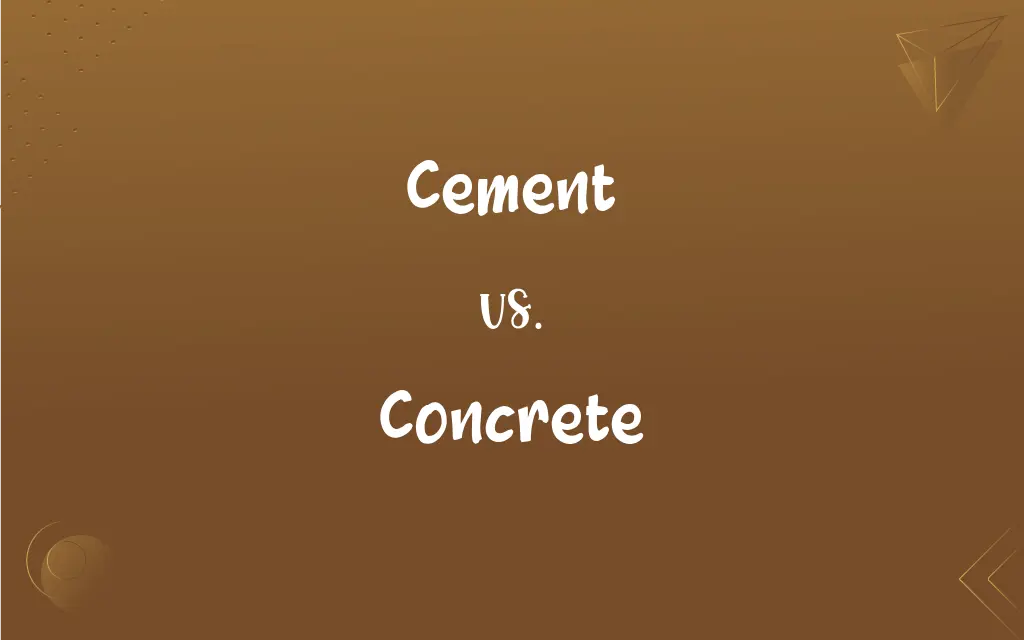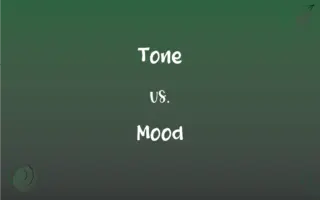Cement vs. Concrete: What's the Difference?
Edited by Aimie Carlson || By Harlon Moss || Updated on June 10, 2024
Cement is a powdery substance used as a binder, while concrete is a mixture of cement, aggregates, and water.

Key Differences
Cement and concrete, though often used interchangeably in casual conversation, serve different purposes in construction. Cement is a finely-ground powdery substance, primarily made from limestone, which acts as a binding agent when mixed with water. Concrete, on the other hand, is a composite material that combines cement with aggregates (like sand and gravel) and water.
The role of cement in construction is vital, as it binds other materials together. When water is added to cement, a chemical reaction called hydration occurs, leading the cement to set and harden. This hardened cement can bind various aggregates and create solid structures. Concrete's strength and durability are derived from this binding process involving cement. However, the presence of aggregates in concrete provides volume and reduces the overall cost.
While cement is an ingredient of concrete, it's essential to understand that it's not the sole component. A typical concrete mix may contain up to 15% cement, with the remainder being water, sand, and larger aggregates. This mixture, when poured and allowed to set, can form structures like buildings, roads, and bridges. The versatility of concrete stems from the various ingredients and their proportions.
Cement types can vary, each designed for specific uses, such as portland cement, which is the most common. However, concrete can be tailored even further by adjusting the type and proportion of aggregates, the water-to-cement ratio, and including additives. This adaptability makes concrete suitable for a vast range of construction projects, from residential homes to vast dams.
In summary, while cement provides the binding property essential in construction, concrete is the broader material used for building, benefiting from cement's binding power and the structural advantage of aggregates.
ADVERTISEMENT
Comparison Chart
Composition
Powdery substance primarily made from limestone
Mixture of cement, aggregates, and water
Use
Binder or adhesive in construction
Used to form structures like buildings and roads
Primary Role
Binding agent
Structural material
Volume in Construction
Used in smaller quantities as an ingredient
Used in larger quantities for structures
Variability
Different types for specific applications
Can be tailored by adjusting ingredients and ratios
ADVERTISEMENT
Cement and Concrete Definitions
Cement
Cement is a primary component in making concrete.
The right amount of cement ensures concrete's strength.
Concrete
Concrete gains strength over time.
The concrete bridge will be stronger in a month than it is today.
Cement
Cement is derived from calcined limestone.
The production of cement involves heating limestone to high temperatures.
Concrete
Concrete is a composite construction material.
Skyscrapers use reinforced concrete for their frames.
Cement
Cement is a binding agent used in construction.
Cement helps bind bricks together in a wall.
Concrete
Concrete combines cement with aggregates and water.
A proper mix of sand and gravel enhances concrete's durability.
Cement
Cement undergoes a chemical reaction when mixed with water.
Adding water to cement initiates the hardening process.
Concrete
Concrete can be molded into various shapes.
Wet concrete was poured into molds to form the sidewalk.
Cement
Cement can set under water.
This property makes cement ideal for underwater construction.
Concrete
Concrete is used for a wide range of structures.
From driveways to dams, concrete's versatility is evident.
Cement
A building material made by grinding calcined limestone and clay to a fine powder, which can be mixed with water and poured to set as a solid mass or used as an ingredient in making mortar or concrete.
Concrete
Of or relating to an actual, specific thing or instance; particular
Had the concrete evidence needed to convict.
FAQs
Can cement be used alone for construction?
While cement can set alone, it's typically mixed with other materials like aggregates to form concrete.
Which lasts longer, cement or concrete?
Concrete, with its combination of ingredients, generally has a longer lifespan.
Is cement environmentally friendly?
Cement production emits CO2, but there are sustainable alternatives and practices emerging.
Why do we see cracks in concrete?
Cracks can result from factors like shrinkage, temperature changes, or structural stress.
Is there a weight difference between cement and concrete?
Yes, concrete, with its added aggregates, is denser and heavier than cement alone.
How do you maintain concrete surfaces?
Regular cleaning, sealing, and repairing minor cracks help extend the life of concrete surfaces.
Can you color concrete?
Yes, concrete can be colored using dyes, stains, or colored aggregates.
How is the strength of concrete measured?
Concrete's strength is typically measured in psi (pounds per square inch) after a curing period.
Do cement and concrete mean the same thing?
No, cement is a binder, and concrete is a mixture including cement, aggregates, and water.
Why is cement gray?
The natural colors of the raw materials, primarily limestone, give cement its gray hue.
Can concrete be recycled?
Yes, old concrete can be crushed and used as aggregate in new mixes.
Can cement set in wet conditions?
Yes, cement can even set under water due to its chemical properties.
What impacts the setting time of cement?
Factors like water content, temperature, and specific cement type can influence the setting time.
How long should concrete cure?
Typically, concrete should cure for at least 7 days, but the longer it cures, the stronger it becomes.
What makes concrete harden?
The hydration reaction of cement when mixed with water causes concrete to harden.
Why are aggregates added to concrete?
Aggregates provide volume, reduce cost, and enhance the strength and durability of concrete.
What's the difference between cement types?
Different cement types have varied ingredients and properties tailored for specific applications.
Why is concrete preferred in construction?
Concrete is durable, versatile, and can be tailored to specific structural needs.
Why is reinforced concrete used?
Reinforcement, typically with steel, improves concrete's tensile strength and overall durability.
Is all cement used to make concrete?
While a primary use of cement is in concrete, it's also used in mortars and other applications.
About Author
Written by
Harlon MossHarlon is a seasoned quality moderator and accomplished content writer for Difference Wiki. An alumnus of the prestigious University of California, he earned his degree in Computer Science. Leveraging his academic background, Harlon brings a meticulous and informed perspective to his work, ensuring content accuracy and excellence.
Edited by
Aimie CarlsonAimie Carlson, holding a master's degree in English literature, is a fervent English language enthusiast. She lends her writing talents to Difference Wiki, a prominent website that specializes in comparisons, offering readers insightful analyses that both captivate and inform.































































